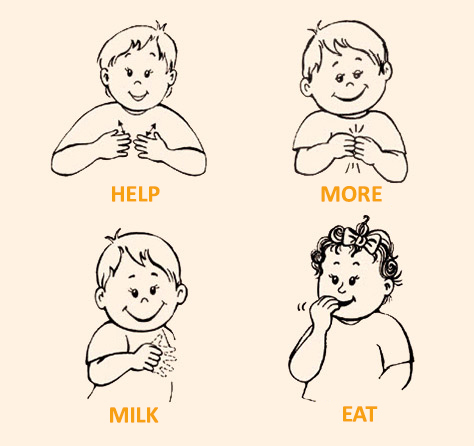Baby sign language: A way to communicate with young children.
Some parents use sign language to communicate with their baby. Is this a good way to help your toddler express themselves?
What is baby sign language?
Baby sign language is a transition language that uses gestures to illustrate common words (e.g., eating, finished, sleeping). However, it is not a substitute for spoken language, but rather used while the adult says the words out loud.
Although signs may be useful in helping early communication, learning them is not essential.
Using signs can sometimes be useful for parents who want to facilitate communication with their baby aged 6 to 24 months, either before they speak or early in their speech learning. At this stage, babies understand several words but cannot say them, which can be frustrating for some.
Before 1 year old, the child can already communicate using gestures. For example, they point their fingers or stretch their arms out. Learning signs could help them communicate their needs more clearly.
Using baby signs can also help parents adopt good communication attitudes. Using signs means the parents wait for their child to look at them to talk, they stand at their height, and they speak less quickly.
Signs can be used with a baby from 6 months old. They can usually start using signs around 10 months old. If they do not, it is not a problem.
How to use signs with a baby
If you choose to use sign language with your baby, say the word while making the sign it represents. Thus, signs do not replace spoken words.
First use signs that represent words in their daily life (e.g., eating, again, milk), because the signs aim to make communication easier. However, pay attention to any non-verbal communication from your child (e.g., mimicking, smiling, crying, natural gestures such as pointing the finger).
In addition, do not put pressure on your toddler to replicate your gestures perfectly. The important thing is to try to understand what they mean, whether they make a gesture or express themselves nonverbally.
Does sign language have an influence on language development?
There is very little reliable research available on the influence of sign language in children who do not have special difficulties. Sign language learning may support, but not accelerate, language development.
Moreover, sign language does not hinder language development. Signs can also help parents adopt good attitudes (e.g., observing the child, respecting the order of speaking, etc.).
What signs should you use?
The signs used to communicate with your baby don’t really matter. For example, there are several ways to make the sign for “again.” As long as your baby associates a sign with a word, they will be able to assimilate its meaning. If you want, you can search the web for examples of signs.
Some childcare services use baby sign language. If this is the case at your child’s daycare facility, you can discuss it with their educator so you can use the same signs at home, if you wish.
Four basic signs
Here are a few words from everyday life and the signs that represent them.

Things to keep in mind
-
Babies can be shown signs starting from 6 months old. They will usually start using them around 10 months old.
-
Sign language allows children who do not yet speak to express their needs, but they are not essential.
-
Always say the word while you make the sign.
| Scientific review: Marie-Ève Bergeron-Gaudin, M. Sc., speech therapist
Research and copywriting:The Naître et grandir team
Updated: June 2022
|
Photo: iStock.com/snapphoto
Illustrations: Signé Bébé
Useful links and resources
Note: Hyperlinks to other sites are not updated on a continuous basis. Thus, some links may not work. In such case, use the search tools to find specific information.
-
KIRK, Elizabeth et al. “To Sign or Not to Sign? The Impact of Encouraging Infants to Gesture on Infant Language and Maternal Mind-Mindedness,” Child Development, 84 (2), March-April 2013, pp. 574-590. doi.org
|